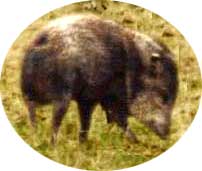
Dimdima
Online Children's Magazine from India

Dimdima
Online Children's Magazine from India

Publicly owned lands, awesome weather conditions and a varied wild life population attract hordes of hunters to Arizona every year. The White-Tail Deer, Desert Mule Deer, Quail, Elk, Antelope, Bear, and Turkey are some of the gaming animals/fowls hunters seek. The Collared Peccary, or Javelina, as they are popularly called is a favourite among hunters. These animals are good to eat and their hides also prove quite useful.
The Collared Peccary is quite an interesting critter. It is the only wild pig-like animal found in the United States. Although javelinas resemble pigs, they are anatomically different from pigs. A large head a long snout distinguishes this animal from the wild pig. It gets its popular name from its razor sharp tusks. Javelin is the Spanish word for spear. Hunters can distinguish javelinas from wild pigs because of their distinct odour. These animals have a powerful musk gland atop their rumps. The musk emits a very powerful odour.
Javelinas travel in groups of several dozens. The largest male javelina is usually the head of the group. Members of the group communicate with one another with the help of "calls." Hunters love to practise different javelina calls and often "call out" to these critters while tracking them in an attempt to get them out into the open. An average male weighs approximately 50 pounds and is about 25 inches tall. Adults are black or gray in color, while babies are reddish-brown. Their bodies are covered by thick coats of coarse bristly hair. They have long thin legs and small hooves. Their hind feet have only three toes each. Like many other wild animals, the groups tend to mark their territory. When they find a spot they like, usually near some water source, these critters rub their rumps on the rocks nearby. The oil from the musk glands rubs off on to the rocks, thereby "marking" property lines.
Peccaries cannot regulate their body temperatures. Hence they tend to rest in the shade of desert trees or rocks during the hot afternoons. They prefer to forage for food during the early hours of the morning or the cooler evenings. These mammals are primarily herbivorous and survive on desert vegetation. The prickly pear cactus is their favourite food. Occasionally javelinas are known to eat insects and reptiles. In Southern Arizona, they are found in large numbers in and around saguaro deserts and mesquite forests.
Coyotes, bobcats and jaguars are the javelinas' natural enemy. Man is another predator who stalks these animals. For many years ranchers and hunters would kill these slow moving animals and leave their carcasses in the desert because they believed peccaries to be carriers of disease. Even today, many hunters steer clear of javelinas because of their "smell." These hunters refer to peccaries as skunk pigs or ranch rats.
Dimdima is the Sanskrit word for ‘drumbeat’. In olden days, victory in battle was heralded by the beat of drums or any important news to be conveyed to the people used to be accompanied with drumbeats.
Bharatiya Vidya Bhavan
K. M Munshi Marg,
Chowpatty, Mumbai - 400 007
email : editor@dimdima.com
Bharatiya Vidya Bhavan
505, Sane Guruji Marg,
Tardeo, Mumbai - 400 034
email : promo@dimdima.com
Dimdima.com, the Children's Website of Bharatiya Vidya Bhavan launched in 2000 and came out with a Printed version of Dimdima Magazine in 2004. At present the Printed Version have more than 35,000 subscribers from India and Abroad.